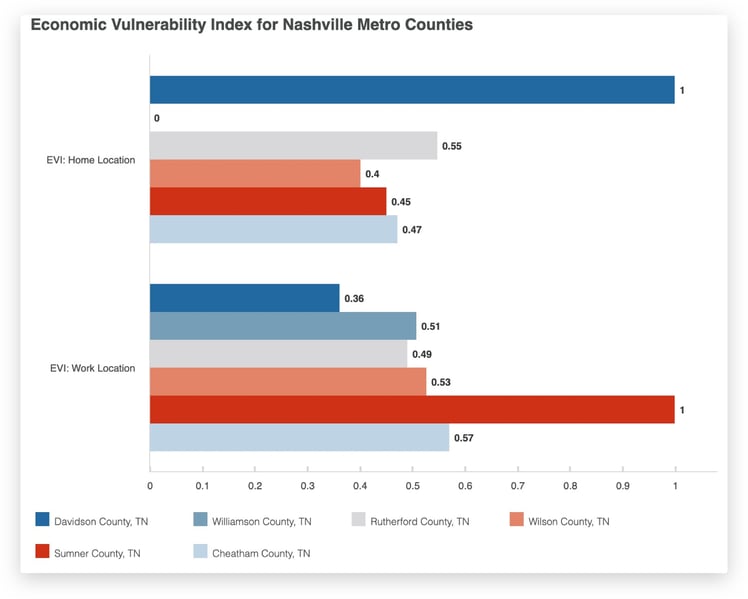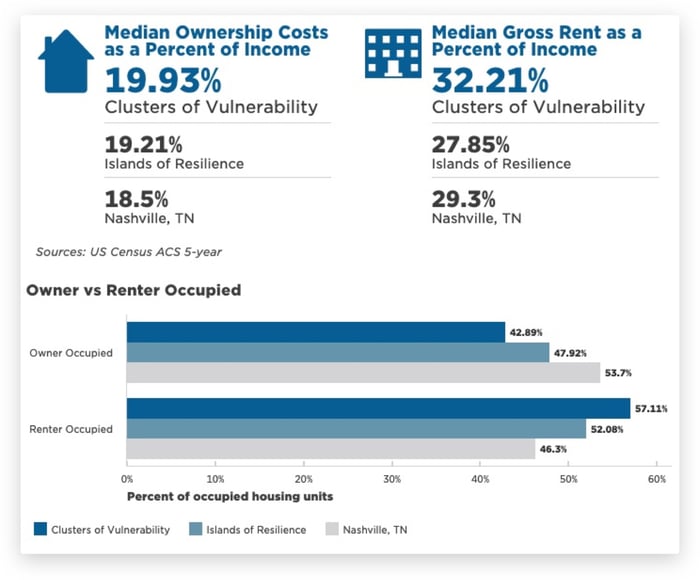Housing and Economic Vulnerability in the Greater Nashville Metro
Understanding the factors behind economic vulnerability is a challenge for all cities. As a Data Storyteller, I have seen how data science can help solve this challenge.
What makes a city vulnerable to things like recessions? Some towns can weather the storm and come out of these events as good or better than before. Many other cities struggle with these events for many years after they are over. What is the difference between the two?
The truth is, economic vulnerability arises from the relationship between many factors. Understanding how these factors interact and what to do about them is a challenge for all cities.
As a Data Storyteller, I have seen how data science can help solve this challenge. Creating an index is a way to take complex conditions and distill them into a few simple numbers. For policymakers and stakeholders, this is a game-changer. Instead of trying to make sense of mountains of data, they can focus on solving the problems.
To help illustrate this, I applied our Economic Vulnerability Index (EVI) to the Greater Nashville Metro Area. The Greater Nashville Metro Area consists of 13 counties in Middle Tennessee. Like all regions, the conditions that create economic vulnerability here are not unique. But the story of which factors make Nashville Resilient and Vulnerable is. These trends also suggest potential actions that local governments can take to keep the region on the right track.
Patterns of Vulnerability
For Greater Nashville Metro Counties, the concentration of vulnerability and resiliency is remarkable.
If we look at where people live, Davidson County has a higher concentration of the economically vulnerable. That means that Davidson County residents are more likely to struggle through recessions. Residents here are more likely to struggle with making ends meet.

Yet, these “high vulnerability” areas are close to places that are faring better. How can one census tract be vulnerable and another - often only a few blocks away - be resilient? We can understand “Why?” by comparing the two areas together. We can call these areas "Clusters of Vulnerability" and "Islands of Resilience," respectively.

One issue that contributes to the resiliency (or vulnerability) of an area is housing. Housing costs for homeowners in the two areas are roughly the same. The national benchmark for housing affordability is 30% of monthly income, and each area comes in below 20%. Yet, for renters, the story is much different.
Nashville’s Clusters of Vulnerability face 13% higher cost burdens for rental housing than Islands of Resilience. Because these areas contain 60% renter-occupied housing, we would expect recessions to have high impacts in these areas.
In short: a main driver of vulnerability in Nashville is that renters bear the burden. When times get tough, renters are likely to struggle the most.
Suggested Actions
So what can Nashville do about these disparities? Different public agencies have different roles to play. Each of these five public agencies can address the housing issues for Nashville’s residents in unique ways.1. Economic Development Professionals
Economic Development helps communities in part by bringing new jobs to the area. One area for Nashville to focus on would be Scientific and Professional industries. In Clusters of Vulnerability, these well-paying jobs represent 10% of all jobs. But in the Islands of Resilience, that number increases to 15%. Economic Development agencies can encourage new companies to locate in Clusters of Vulnerability. Additionally, they can support entrepreneurs and connect them to opportunities. Finally, they can promote job training programs.
2. Transportation Professionals
Nashville’s Islands of Resilience have 18% of the population of Clusters of Vulnerability. Yet, they have access to more than double the number of jobs by public transit (within a single 30-minute trip). Increasing transit accessibility in areas that need it the most would increase resilience. Additionally, supporting Transit-Oriented Development would bring housing and transportation together.
3. Housing and Community Development Professionals
The cost of rental housing is a substantial concern for Nashville’s Clusters of Vulnerability. Mobilizing resources to support households through the COVID-19 pandemic is critical. These resources could include rental assistance, eviction moratoriums, utility shutoff moratoriums, and more. An even longer-term strategy could be to enable more residents to own their homes.
4. Education Professionals
Thirteen percent of households in Nashville’s Clusters of Vulnerability do not have a computer at home. In the Islands of Vulnerability, this figure is seven percent. Closing the digital divide is critical, especially for students. Schools can empower students by connecting resources to those who need them most. These resources would also promote economic development by preparing students for jobs in tech. Few investments are likely to have as big of an impact as investments in quality K-12 education.
5. Public Health Professionals
ODPHP (the Office of Disease Prevention and Health Promotion) researches the link between housing instability and poor health outcomes. Through this work, we know that housing plays a critical role in personal and population health. This manifests in a few ways:
- Physical stress of the environment
- Mental stress of the environment
- Presence of developmental hazards like lead
- Presence of carcinogenic hazards like asbestos
- Difficulty accessing healthcare and other critical services due to frequent relocation
For public health professionals, improving housing affordability and stability is vital. “Upstream” interventions for health issues that would otherwise go unnoticed are often the result. Public health professionals need a seat at the table on housing policy.
Explore The Economic Vulnerability Index
Curious about the vulnerabilities and resiliency of your community or the process of making an index? Download our Economic Vulnerability Index (EVI) White Paper to review our nationwide analysis complete with methodology, county rankings, data and more.
Want to get in touch? Learn more about mySidewalk, or reach out to connect with us.
Share this
You May Also Like
These Related Stories

The Perfect Fit: HUD Low-Mod Data in mySidewalk

Why The New HUD Rule Change Is a Mission Critical Problem



No Comments Yet
Let us know what you think